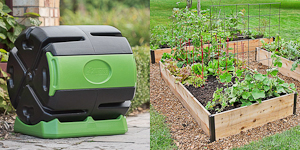- Home
- How to Grow Vegetables A-Z
- How to Grow Potatoes
How to Grow Potatoes
For Maximum Yield and Nutrition
How to Grow Potatoes Is An Ancestral Skill
Knowing how to grow potatoes was a skill almost everyone possessed until a few decades ago, because growing potatoes meant food security. Through both good times and bad, whether baked, boiled, mashed or fried, potatoes have been a staple crop in much of the world for millennia. I used to think potatoes were nothing but starch with little nutritional value. I was wrong.
The humble spud packs more protein than any other plant food save lentils (on a dry-weight basis), and a medium-sized potato has almost as much vitamin C as an orange!
And in hard times, potatoes excel as nutritious, home-grown survival food. So everyone with even a small bit of ground can benefit from knowing how to grow potatoes. Whether as a back-pocket skill, a thread of connection to our ancestors, or a practiced, practical skill, knowing how to grow potatoes is empowering.
To Learn How to Grow Potatoes We Must Understand How Potatoes Grow
But before we learn how to grow potatoes, we first need to know a bit about how potatoes grow, so we can take advantage of their quirks to get the highest yield as well as the most flavor and nutrition for our efforts. Before you take your spade to the ground, please read through this part, as it's not just a matter of the right planting depth.
Most people know that the potato that we eat is not actually a root (like a carrot is), but rather a tuber, which is an underground storage vault for the sugars that the plant's leaves are producing up top.
"Potato Seed" vs. "Seed Potatoes"
All flowering plants produce seeds, including potatoes. Seeds are those little miraculous packages of DNA that contain all the information and initial energy required to grow a whole new plant. While you can buy a packet of potato seeds and grow potatoes that way, it is tricky and you usually won't get the qualities or yield you want because of genetic variation.
So most people plant seed potatoes, which aren't seeds at all, but rather cut pieces of a potato tuber that has 1-3 "eyes" on it. The potatoes that will grow from it will be exact duplicates ("clones") of the potato piece you planted, so you'll get the exact variety you want, as well as higher yields.
It is best to buy certified disease-free seed potatoes from a reputable nursery or online source because many potatoes carry blight spores, especially the ones you buy at the supermarket. Most supermarket spuds have also been treated with chemicals that suppress sprouting.
How to Grow Potatoes for Maximum Yield
What sprouts out of a potato's "eye" is technically neither a root nor a
stem. It is called a "stolon" and has nodes along its length that give
rise to either roots, which grow out and down into the soil to gather
nutrients, or stems, which grow upward into the light to grow leaves and
gather sunlight. Those of you who also grow strawberries will recognize
the stolon as a "runner". Strawberries grow their stolons above ground,
while potatoes grow them underground.
If we
plant our seed potatoes too deeply, they will grow plenty of roots but
the development of leaves above ground will be slow. But if we plant too
shallowly, potatoes will form close too the surface where they'll turn
green and become quite toxic. (More on green potatoes here - it's
important!).
We're going to take
advantage of this knowledge to grow the most potatoes with the highest
flavor and nutrition possible on any given piece of ground.
What we're aiming for is to maximize both leaf
development above ground and root development below ground. So we need a
technique that will balance top and bottom growth, which we can do when
we know how to plant potatoes the most efficient way.
Because there's a lot to
know, to keep this article from becoming too long, I have broken the
information up into the following sections:
|
How to Harvest |
How to Store |
Help share the skills and spread the joy
of organic, nutrient-dense vegetable gardening, and please...
~ Like us on Facebook ~
Thank you... and have fun in your garden!
Affiliate Disclaimer
This website contains affiliate links to a few quality products I can genuinely recommend. I am here to serve you, not to sell you, and I do not write reviews for income or recommend anything I would not use myself. If you make a purchase using an affiliate link here, I may earn a commission but this will not affect your price. My participation in these programs allows me to earn money that helps support this site. If you have comments, questions or concerns about the affiliate or advertising programs, please Contact Me.Contact Us Page



